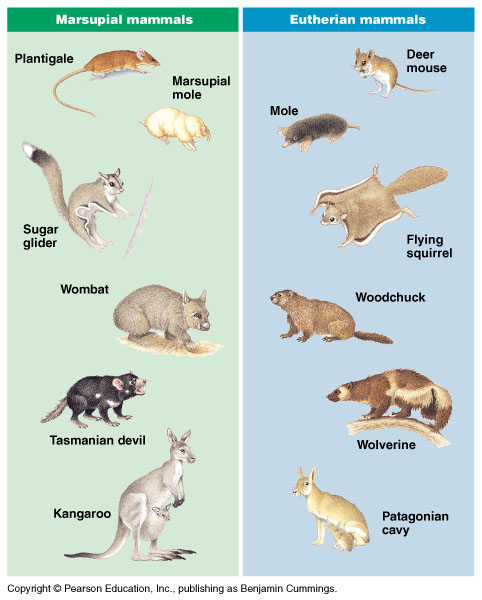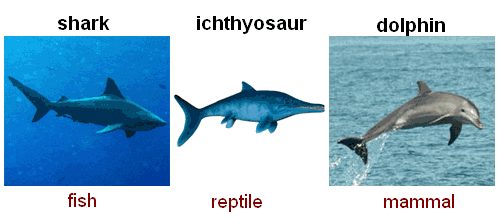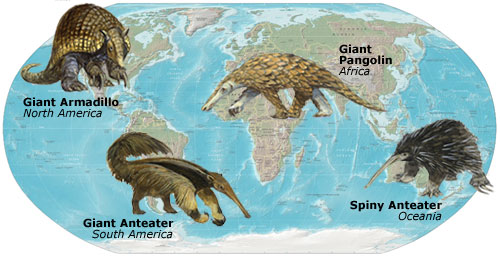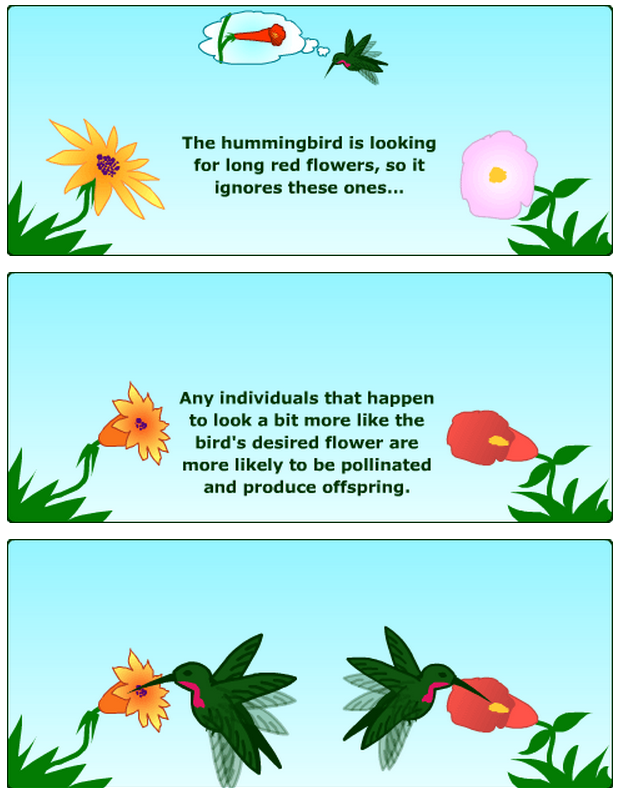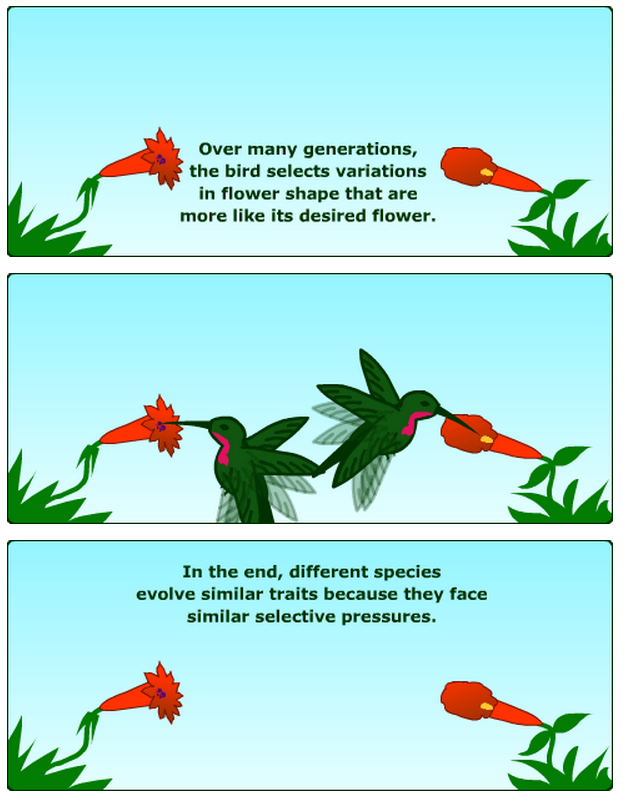Convergent evolution – When two or more very different species somehow develop (more or less) what appear to be the same features.
Consider the evolution of wings in
• Pterosauria (pterosaurs) – a type of reptile
• Aves (birds) – any type of bird
• Chiroptera (bats) – mammals
All developed “wings,” obviously – yet they did so totally independently!
What happened? Nature converged on the same solution for a particular problem.
That’s why this phenomenon is called convergent evolution.
I’m putting the word wings” in quotes, because although they appear to have the same job, they each evolved from a different earlier form.
Over millions of years, evolution has converged on a flight solution for many species of insects:
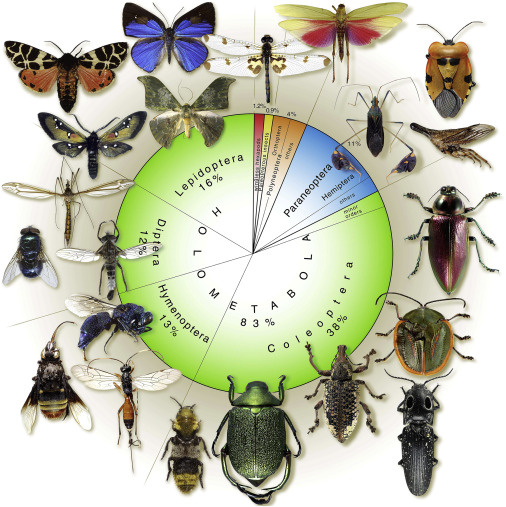
from Grimaldi and Engel, Evolution of the Insects
above picture from Insect Evolution
Over millions of years, evolution has converged on a flight-like solution for a few species of fish – e.g. the flying fish.
Over millions of years, evolution has converged on a flight-like solution for some squirrels.
Over millions of years, evolution has converged on a flight-like solution for some species of trees:
Some trees have seeds with wing-like adaptations.
All of these are often called “analogous features.”
For instance, as we see here, bat “wings” are really skin stretched out over an elongated hand. Notice the fingers inside the wing!
Bird wings are skin stretched out over an entire arm.
That’s right, bird wings were originally arms – and to a certain extent, they still are.
For that matter, a century of study has confirmed that birds are a specially evolved form of dinosaur.
(They evolved from some of the smaller dinosaur lines, but they still maintain a lot of anatomical similarities.)
How about those pterosaurs? For starters, contrary to popular belief, these aren’t dinosaurs.
They may have lived during roughly that same time period, but these creatures are actually reptiles.
How did reptiles develop wings?
If we look at their fossils, their bones tell us the story:
Through evolution by natural selection, some reptiles developed hands into wings: Look closely at what you see here!
This image is by exdraghunt from Deviantart.
So reptiles, mammals, and aves (birds) are developed similar structures, at different times, from slightly different body body parts.
These new parts – wings – aren’t the same, but they certainly do the same kind of thing.
They are analogous structures. What is an analogy?
An analogy is a comparison between two objects, that highlights ways in which they are similar.
Analogous structures look similar to each other, and even do similar jobs.
Yet they did not evolve from a common structure – they evolved independently.
Placental mammals vs Marsupial Mammals
Mammals that you and I are familiar with all evolved in Africa, Asia, Europe and the Americas.
They still live there today.
But a separate branch of animals evolved that today only live in Australia and New Zealand – the Marsupial mammals.
These are animals that have pouches, like kangaroos.
They are not closely related to the regular mammals that you and I are used to.
Yet look carefully at the same of Australian marsupial mammals:
they somehow evolved to have almost the same shape and behavior as the other mammals!
Why? Even thought they had very different ancestors, they faced the same problems
(finding food, protecting themselves from predators, moving from place to place.)
And over time their designs converged on similar solutions.
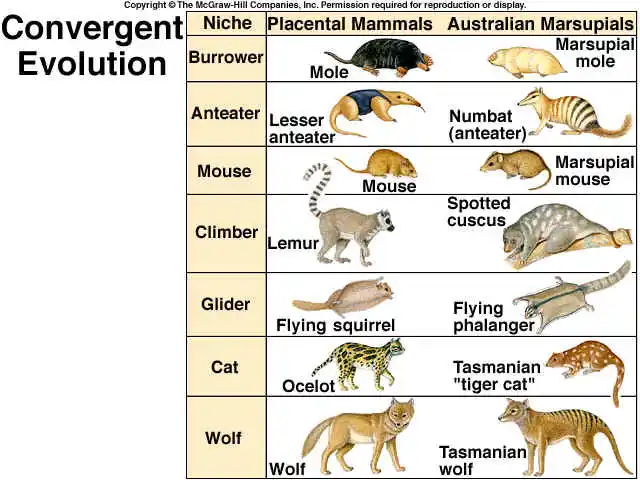
{ from http://animalwise.org/2011/09/26/converging-with-canines-are-humans-and-dogs-evolving-together/ }
Here are more examples. The marsupials – left – are only in New Zealand and Australia.
The Eutherian (“regular”) mammals are on the right.
What about in the oceans? Do similar convergent solutions develop there as well?
You betcha! Consider these: Some fish, reptiles, and mammals developed on the the same basic shape for adapting to the oceans.
What about anteaters? Nothing else converged on their solutions (finding food, avoiding being eater), did they? You betcha that some other animals converged on the same solution!!
Credits: Courtesy of Michael Rothman. PBS Evolution website
How can this happen in plants?
from Understanding Evolution http://evolution.berkeley.edu/
How can different animals converge on the same solution?
See Evolution of insect flight, a stepwise model based on weight-supported locomotion on the surface of water.
Also see Evolution of Insect Wings, The Flight of the Bumblebee











